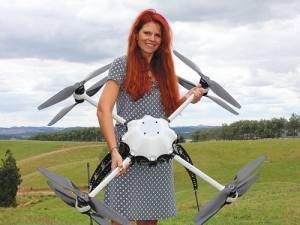Wairarapa’s Bradley Wadsworth blends farming and technology
Bradley Wadsworth lives on the family farm – Omega Station – in the Wairarapa about 30 minutes’ drive east from Masterton.
 Linda Bulk, sales director at Aeronavics NZ, displays one of the many UAVs now available for on-farm use in New Zealand.
Linda Bulk, sales director at Aeronavics NZ, displays one of the many UAVs now available for on-farm use in New Zealand.
We've all seem remote controlled helicopters for the kids at the airport duty free counter, but commercial UAV’s take the game to a whole new level and can offer some tangible benefits for agriculture or horticulture.
Commercial units fall into two distinct camps, either fixed wing or multi-rotor, each offering benefits and disadvantages.
Fixed wing machines have higher payload capacities, but need larger areas for takeoff and landing and can be difficult to transport – whereas multi-rotor designs tend to be easier to transport, need only a small area to deploy, but have more limitations on payload.
The subject of fuel also kicks in with regards to load capacities, range and flying times.
The key point, as with the trusty farm tractor, is what are you going to put behind – or in this case – underneath the UAV to give you information? The options include real time video, near infra-red, thermal or multi-spectrum cameras.
Each has something to offer, but what does it mean in terms of practical on farm use?
On a livestock enterprise there is a potential to save time and money. On the former, the old 80:20 rules applies with regards to looking for problems then dealing with them.
A UAV with a real-time video camera can cover in 15 minutes a farm that might take 90 minutes on a quad. This has the potential to reduce the distance travelled on the typical farm vehicle by many thousands of kilometres a year, save a great deal of fuel and reduce the likelihood of accidents.
It could patrol the water troughs looking for leaks, monitor and muster sheep and spot any cast ewes. In financial terms alone, saving 40 sheep at a value of $300 each realises $12,000 per year.
From a management perspective on the same farm, it could be used to check for weeds or pests, or to map the farm or the drain layout in a about an hour, compared to hiring a helicopter for half a day at around $1600.
In arable or cropping situations, it has the same benefits of overlooking crops for weeds and pests, and multi-spectrum cameras can be used to look for particular traits such as crop densities, plant populations and specific diseases. With a multi-rotor unit, there is even the option of stopping, hovering and zooming in on particular targets and targeted precision spraying in orchards and vineyards.
These units also have potential, especially on very large land areas, to look at normally inaccessible areas, thereby improving safety, surveying areas that have been damaged by weather or fire and using thermal imaging to find missing livestock or people.
So the question many will ask is: “I struggle to set the video recorder or tune my car radio…. will I need to employ a fourteen year old to fly this thing for me?”
The answer is you’ll probably need a little training from the supplier or your teenager, but if you have a bit of a handle on the humble computer you should be ok. Most machines can be flown manually, but can also be pre-programmed to fly a pre-prescribed route by GPS and even return home if fuel starts to get low.
The rules
The National Wild Goat Hunting Competition has removed 33,418 wild goats over the past three years.
New Zealand needs a new healthcare model to address rising rates of obesity in rural communities, with the current system leaving many patients unable to access effective treatment or long-term support, warn GPs.
Southland farmers are being urged to put safety first, following a spike in tip offs about risky handling of wind-damaged trees
Third-generation Ashburton dairy farmers TJ and Mark Stewart are no strangers to adapting and evolving.
When American retail giant Cosco came to audit Open Country Dairy’s new butter plant at the Waharoa site and give the green light to supply their American stores, they allowed themselves a week for the exercise.
Fonterra chair Peter McBride says the divestment of Mainland Group is their last significant asset sale and signals the end of structural changes.

OPINION: Your old mate welcomes the proposed changes to local government but notes it drew responses that ranged from the reasonable…
OPINION: A press release from the oxygen thieves running the hot air symposium on climate change, known as COP30, grabbed your…